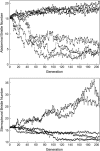Polygenic mutation in Drosophila melanogaster: Mapping spontaneous mutations affecting sensory bristle number
- PMID: 15944368
- PMCID: PMC1449762
- DOI: 10.1534/genetics.104.032581
Polygenic mutation in Drosophila melanogaster: Mapping spontaneous mutations affecting sensory bristle number
Abstract
Our ability to predict long-term responses to artificial and natural selection, and understand the mechanisms by which naturally occurring variation for quantitative traits is maintained, depends on detailed knowledge of the properties of spontaneous polygenic mutations, including the quantitative trait loci (QTL) at which mutations occur, mutation rates, and mutational effects. These parameters can be estimated by mapping QTL that cause divergence between mutation-accumulation lines that have been established from an inbred base population and selected for high and low trait values. Here, we have utilized quantitative complementation to deficiencies to map QTL at which spontaneous mutations affecting Drosophila abdominal and sternopleural bristle number have occurred in 11 replicate lines during 206 generations of divergent selection. Estimates of the numbers of mutations were consistent with diploid per-character mutation rates for bristle traits of 0.03. The ratio of the per-character mutation rate to total mutation rate (0.023) implies that >2% of the genome could affect just one bristle trait and that there must be extensive pleiotropy for quantitative phenotypes. The estimated mutational effects were not, however, additive and exhibited dependency on genetic background consistent with diminishing epistasis. However, these inferences must be tempered by the potential for epistatic interactions between spontaneous mutations and QTL affecting bristle number on the deficiency-bearing chromosomes, which could lead to overestimates in numbers of QTL and inaccurate inference of gene action.
Figures
Similar articles
-
High-resolution mapping of quantitative trait loci for sternopleural bristle number in Drosophila melanogaster.Genetics. 1999 Aug;152(4):1585-604. doi: 10.1093/genetics/152.4.1585. Genetics. 1999. PMID: 10430585 Free PMC article.
-
Mapping and characterization of P-element-induced mutations at quantitative trait loci in Drosophila melanogaster.Genet Res. 1993 Jun;61(3):177-93. doi: 10.1017/s0016672300031359. Genet Res. 1993. PMID: 8396063
-
Polygenic mutation in Drosophila melanogaster: genetic interactions between selection lines and candidate quantitative trait loci.Genetics. 1996 Oct;144(2):671-88. doi: 10.1093/genetics/144.2.671. Genetics. 1996. PMID: 8889529 Free PMC article.
-
The genetic basis of quantitative variation: numbers of sensory bristles of Drosophila melanogaster as a model system.Trends Genet. 1995 Dec;11(12):464-70. doi: 10.1016/s0168-9525(00)89154-4. Trends Genet. 1995. PMID: 8533161 Review.
-
The nature of quantitative genetic variation revisited: lessons from Drosophila bristles.Bioessays. 1996 Feb;18(2):113-21. doi: 10.1002/bies.950180207. Bioessays. 1996. PMID: 8851044 Review.
Cited by
-
Associations between sperm competition and natural variation in male reproductive genes on the third chromosome of Drosophila melanogaster.Genetics. 2007 Jun;176(2):1245-60. doi: 10.1534/genetics.106.064915. Epub 2007 Apr 15. Genetics. 2007. PMID: 17435238 Free PMC article.
-
Causes and consequences of genetic background effects illuminated by integrative genomic analysis.Genetics. 2014 Apr;196(4):1321-36. doi: 10.1534/genetics.113.159426. Epub 2014 Feb 5. Genetics. 2014. PMID: 24504186 Free PMC article.
-
Mutations and quantitative genetic variation: lessons from Drosophila.Philos Trans R Soc Lond B Biol Sci. 2010 Apr 27;365(1544):1229-39. doi: 10.1098/rstb.2009.0315. Philos Trans R Soc Lond B Biol Sci. 2010. PMID: 20308098 Free PMC article. Review.
-
Mesosternal bristle number in a cosmopolitan drosophilid: an X-linked variable trait independent of sternopleural bristles.J Genet. 2007 Aug;86(2):149-58. doi: 10.1007/s12041-007-0019-6. J Genet. 2007. PMID: 17968142
-
Empirical measures of mutational effects define neutral models of regulatory evolution in Saccharomyces cerevisiae.Proc Natl Acad Sci U S A. 2019 Oct 15;116(42):21085-21093. doi: 10.1073/pnas.1902823116. Epub 2019 Sep 30. Proc Natl Acad Sci U S A. 2019. PMID: 31570626 Free PMC article.
References
-
- Adams, M. D., S. Celniker, R. A. Holt, C. A. Evans, J. D. Gocayne et al., 2000. The genome sequence of Drosophila melanogaster. Science 287: 2185–2195. - PubMed
-
- Barton, N., and M. Turelli, 1989. Evolutionary quantitative genetics: How little do we know? Annu. Rev. Genet. 23: 337–370. - PubMed
-
- Clayton, G. A., and A. Robertson, 1955. Mutation and quantitative variation. Am. Nat. 89: 151–158.
MeSH terms
LinkOut - more resources
Full Text Sources
Molecular Biology Databases


